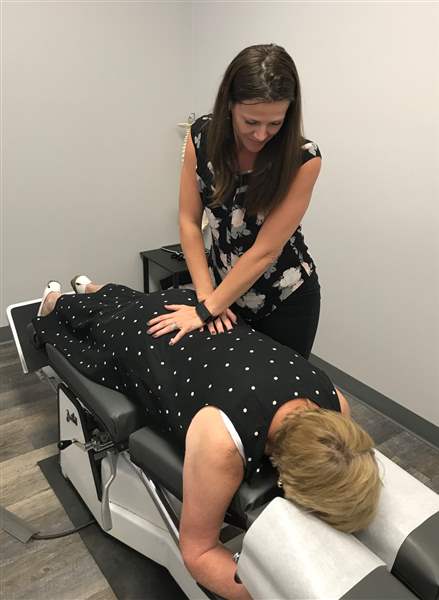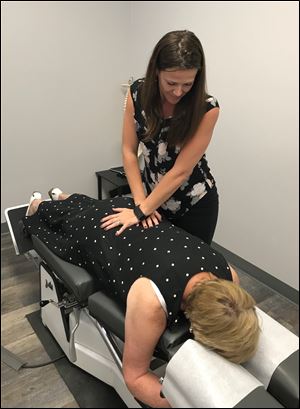
A healing touch
Can chiropractic therapy help stem opioid tide?
9/9/2018
Jessica Lockhart is a chiropractor who opened Healthy Family Chiropractic LLC in Sylvania in January.
THE BLADE/BRIAN DUGGER
Buy This Image
BY THE NUMBERS
• The Centers for Disease Control and Prevention reported 72,000 U.S. deaths from drug overdoses in 2017.
• According to a 2017 Lucas County sheriff's department study, three people a week die of an opioid overdose in Lucas County.
• The Ohio Department of Health reported 4,065 overdose deaths in Ohio in 2016. The CDC says that the state’s number increased by at least 17 percent in 2017.
• According to the Mayo Clinic, anyone who takes opioids is at risk of developing addiction, and it can happen almost immediately for some people.
• 20 million people visit chiropractors annually, according to the American Chiropractic Association.
• Opioids are a class of drugs, including heroin, that are naturally found in the opium poppy plant.
• Prescription opioids can be natural or synthetically produced by scientists.
For Tyler Vargo of Rossford, the downward spiral started with bunion surgery when he was 15.
Vicodin was prescribed for his pain. He abused it. First it was 5 milligrams, then 20, then 30 milligrams. Eventually it was 10 30s a day.
“Cigarettes tasted better, my mood was better, everything was better,” Mr. Vargo says.
The stories are often repeated inside Holland’s Racing for Recovery.
As an opioid epidemic continues to ravage Ohio, counselors at Racing for Recovery see, and try to save, many of its victims.
Brandon Hodnett of Toledo fell off a bucket truck and injured his back. Oxycodone was his savior, then his tormentor. Mike Ward, Jr., of Sycamore medicated with painkillers for back pain and broken bones.
“They never told me that it only takes four or five days to get addicted,” Mr. Ward says.
In August, the Centers for Disease Control and Prevention reported that drug overdoses killed 72,000 Americans in 2017. According to the Ohio Department of Health, 4,050 overdose deaths occurred statewide in 2016. The CDC’s latest report said the total overdose deaths in Ohio increased by at least 17 percent last year. Opioids are the clear-cut driver behind the epidemic. The drugs are highly addictive, and when new addicts can no longer get a doctor to write a prescription, they often turn to heroin, which affects the pleasure centers of the brain in a similar fashion as opioids and can be purchased cheaply on the streets. The heroin is increasingly being mixed with potent and deadly fentanyl or carfentanil to stretch a dealer’s supply.
Clinicians and law enforcement officials say every time a heroin addict shoots the drug into his body, he is playing Russian roulette. What begins as relief from pain associated with minor surgery, turns into a death sentence for thousands of Americans.
“There is this stigma that addicts are not good people, that they want to be addicted. That is simply not true,” says Jessica Lockhart, a chiropractor who opened Healthy Family Chiropractic LLC in Sylvania in January.
Her original intent was to focus on pediatric/pregnancy and family wellness, but Ms. Lockhart has discovered that she can make a difference in the opioid epidemic. She treats 8 to 10 Racing for Recovery clients once a week, giving them an alternative to pain pills. She attended a support meeting at the Holland facility in February and knew that her knowledge could help the people she met.
“There are studies on brain pathways and neurons, that if they are not firing in correct sequence, that our bodies can never feel that sense of calm. A lot of people choose drugs and alcohol to experience that high or sense of well-being,” Ms. Lockhart says. “When we realign the spine and allow the body to function at its absolute best, you get that sense of calm and well-being. Chiropractors are trying to become the frontrunners in the opioid issue. We want to prevent the using of pain pills so people don’t go down that road.”
During a chiropractic adjustment, a patient often lies face down on a table and the chiropractor uses his or her hands to apply a controlled, sudden force to a joint or spine, sometimes causing pops or cracks, though not always. The idea is that once the spine is in alignment, the body functions more efficiently and injuries can heal quicker or be avoided.
Chiropractors themselves can be victims of stigmatization. A 2015 Gallup survey found that one out of four Americans believed chiropractic care was dangerous, but that percentage rose to 47 percent among those who had never seen a chiropractor. But last May, the Food and Drug Administration urged doctors to educate themselves about and be open to recommending chiropractic care as an alternative to opioids in treating some types of pain.
The American College of Physicians has echoed that recommendation, saying that one option for low-back pain could be the use of alternative therapy, such as chiropractic therapy, acupuncture, and massage.
“The American Chiropractic Association is encouraged by the growing recognition of the value and effectiveness of nondrug approaches, such as chiropractic spinal manipulation, for low back pain treatment,” says N. Ray Tuck, Jr., the president of the ACA. “The ACA urges people to try nonopioid treatments for low back pain first before resorting to prescription pain medications.”

Jessica Lockhart is a chiropractor who opened Healthy Family Chiropractic LLC in Sylvania in January.
Dr. Rashid Kalil, the section chief of pain management at Mercy Health-St. Anne Hospital, says chiropractic therapy, acupuncture, and massages have been extremely useful for some of his patients. He says a chiropractor can be especially effective with patients who have chronic back spasms, but he recommends a trip to the doctor’s office before beginning therapy.
“You don’t lose anything by being careful,” Dr. Kalil says. “If you are into chiropractic treatment, you should still get an evaluation and an [X-ray] done.”
An X-ray would rule out any existing spinal injury that could result in paralysis from aggressive spinal manipulation. He says people who suffer from osteoporosis or a spinal malignancy are at particular risk of spinal injury from manipulation because of their low bone strength.
“It’s not going to work for everyone, but [chiropractic care] is a good alternative to painkillers,” Dr. Kalil says. “There are 20 million people who visit chiropractors annually, so they must be receiving some kind of relief, which is why they keep going.”
Todd Crandell, the founder of Racing for Recovery, was drinking by the time he was 13 and doing cocaine by 16. Heroin, crack, and painkillers followed. He pulled himself out of his potential death spiral by pouring his addictive energy into endurance racing. He has completed about 30 Ironman triathlons. The race includes a 2.4-mile swim, a 112-mile bike ride, and a 26.2-mile run. In the past year, a shin fracture and numerous nagging injuries sidelined him from his vigorous training. Around the same time, Ms. Lockhart contacted him about helping out at Racing for Recovery.
“I asked her: Can you help put me back together while you are helping Racing for Recovery?” Mr. Crandell says.
He is adjusted several times a week and completed a full Ironman in June.
“She’s been instrumental in me getting back out there doing crazy things,” Mr. Crandell says. “Her getting me aligned gave me the ability to physically be consistent in my running and enhanced my mood and motivation. Getting adjusted is like a spark that ignites everything else I do.”
For addicts, the mental benefit from chiropractic therapy is a powerful part of their self-care.
“If your body is right, the mental falls in place. When you are in pain, you are depressed,” says Mr. Hodnett, who says he used to take 1,600 milligrams of Ibuprofen a day to deal with his back pain. He says he has not taken a single pain reliever since receiving weekly chiropractic care.
“If I feel good mentally, then I’m more driven to do other things with my recovery,” Mr. Crandell says. “It all feeds off of each other. If I feel good mentally and emotionally, I’m more apt to exercise. If I exercise, then I’m more apt to eat right. It’s just this circle of constant awesomeness.”
Ms. Lockhart has a photo of her adjusting her daughter in the birthing tub. Her entire family receives regular treatment. Prior to coming to Sylvania, she worked at a chiropractor’s office in Cleveland for four years. The idea of working with addicts was brought up and quickly squashed by others in the office.
“I don’t think that they understood that these are just people. They are great people too,” Ms. Lockhart says. “This treatment helps with the pain so they don’t need pain medication. It helps with depression, helps with anxiety and mood. When you feel good, you will make better choices for yourself.”
Contact Brian Dugger at bdugger@theblade.com or on Twitter @DuggerBlade.